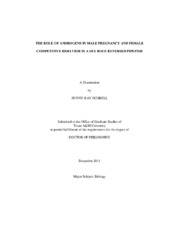| dc.contributor.advisor | Jones, Adam G. | |
| dc.contributor.advisor | Rosenthal, Gil G. | |
| dc.creator | Scobell, Sunny Kay | |
| dc.date.accessioned | 2012-02-14T22:20:50Z | |
| dc.date.accessioned | 2012-02-16T16:18:16Z | |
| dc.date.available | 2012-02-14T22:20:50Z | |
| dc.date.available | 2012-02-16T16:18:16Z | |
| dc.date.created | 2011-12 | |
| dc.date.issued | 2012-02-14 | |
| dc.date.submitted | December 2011 | |
| dc.identifier.uri | https://hdl.handle.net/1969.1/ETD-TAMU-2011-12-10676 | |
| dc.description.abstract | The sex-role reversal and male pregnancy found in syngnathids are highly unusual traits in vertebrates. Reproductive hormones likely influence development and regulation of these traits. However, very few studies have examined the underlying hormonal mechanisms that mediate female competitive behavior and male pregnancy. New methodologies and better husbandry practices have made such studies more feasible in recent years. Research on a relatively small number of species has suggested that androgens are likely regulators of spermatogenesis and the development of the male brood pouch prior to pregnancy. Androgens are also potential candidates for mediating sex-role reversed behavior in female syngnathids. The goal of this dissertation was to examine the role of androgens in the male reproductive cycle and female intrasexual competitive behavior in the sex-role reversed Gulf pipefish, Syngnathus scovelli.
From review of the literature, I developed a model for the hormonal regulation of the male reproductive cycle in seahorses. I predicted that androgens would be low during the early stages of pregnancy and increase during the end of pregnancy as males go through another cycle of spermatogenesis in preparation for the next mating event. My study of 11-ketotestosterone and testis mass across the reproductive cycle in male S. scovelli supported this model. I also conducted several studies on the role of androgens in female competitive behavior. I determined that treatment with 11-ketotestosterone the evening prior to an intrasexual interaction resulted in an increase in competitive behavior in large over small test females. Conversely, treatment with 11-ketotestosterone one hour prior to an intrasexual interaction resulted in a decrease in competitive behavior in large over small females when stimulus female behavior was controlled. A comparative study of competitive and courtship behavior in S. scovelli and the closely related S. floridae suggested that sexual selection has affected competitive and courtship behavior in both males and females of these species. The diversity of reproductive patterns exhibited by syngnathids suggests that they will provide a unique opportunity to assess how hormonal regulation of reproductive behavior and function has evolved within this lineage. | en |
| dc.format.mimetype | application/pdf | |
| dc.language.iso | en_US | |
| dc.subject | Sexual selection | en |
| dc.subject | sex-role reversal | en |
| dc.subject | Syngnathidae | en |
| dc.subject | endocrinology | en |
| dc.subject | androgens | en |
| dc.subject | steroids | en |
| dc.subject | male pregnancy | en |
| dc.subject | female intrasexual competition | en |
| dc.subject | female aggression | en |
| dc.subject | Gulf pipefish | en |
| dc.subject | Syngnathus scovelli | en |
| dc.title | The Role of Androgens in Male Pregnancy and Female Competitive Behavior in a Sex Role Reversed Pipefish | en |
| dc.type | Thesis | en |
| thesis.degree.department | Biology | en |
| thesis.degree.discipline | Biology | en |
| thesis.degree.grantor | Texas A&M University | en |
| thesis.degree.name | Doctor of Philosophy | en |
| thesis.degree.level | Doctoral | en |
| dc.contributor.committeeMember | MacKenzie, Duncan S. | |
| dc.contributor.committeeMember | Jaques, John T. | |
| dc.type.genre | thesis | en |
| dc.type.material | text | en |


